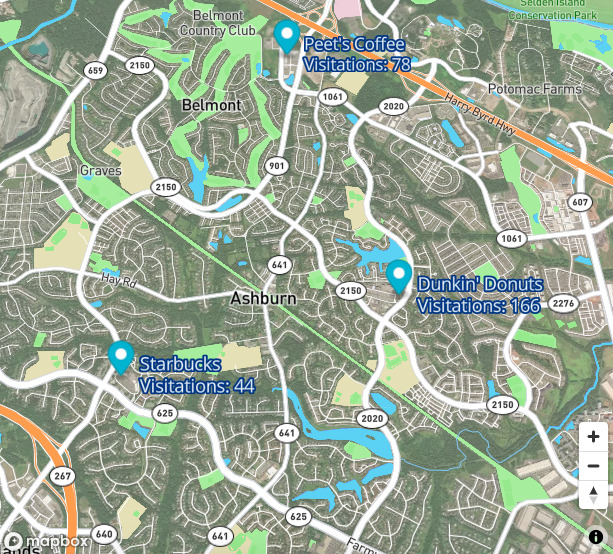Business Activity and Competitive Analysis for Market Research: 3 Things You Need to Know
March 30, 2021

As companies plan for a post-COVID world, the importance of analyzing business activity for competitive analysis has increased exponentially. Market researchers often use sales data and other forms of data to measure activity, but they shouldn’t use these metrics alone; customer traffic activity is just as important, especially for competitive analysis.
Market research companies can help their clients by analyzing the business activity of their competitors. Want to learn how? Here are three things you need to know about analyzing business activity for competitive intelligence.

1. What Brings in Customers?
Recently, we wrote a study about 2020 coffee trends. We noticed that Dunkin’ brought in far higher foot traffic than its counterparts. But, does this national trend persist at a smaller level? Keep this in mind as we dive into the details of this mini-competitive analysis using the Gravy Visitations API.
Let’s say you are a market research firm working with a client who is interested in opening a new coffee shop in Ashburn, VA. The proposed location is near existing Peet’s, Starbucks, and Dunkin’ locations. Analyzing foot traffic data at these three stores for the previous year, you notice that Dunkin’ not only had higher average daily foot traffic overall, but spikes in traffic on both Valentine’s Day and National Donut Day. Upon closer inspection, you notice that Dunkin’ ran special promotions on those days. With the right data solutions and tools in place, your client decides to add donuts and pastries to the menu, and to create campaigns competing with Dunkin’s marketing efforts around Valentine’s Day and National Donut Day.
By understanding what brings in the competition’s customers, businesses can create a data-driven strategy to redirect that customer traffic to their door instead.

2. Is Your Client Looking for a New Location?
Business activity (or the lack thereof) can make or break your client’s plans to open a new storefront. For this section, imagine that your client hired your firm to help them understand the consumer foot traffic and competitive landscape before committing to a lease for their new coffee shop.
You zero in on three available storefronts within range of where your client is thinking about opening their new location. Data shows that all three shopping centers (where the available storefronts are located) boast strong consumer foot traffic during weekdays and weekends, and morning, noon, and night. Two of the three locations are more interesting because the data also shows they attract your client’s target market.
You then decide to take a closer look at the behavior of your competitors’ customers: you notice that they usually live within a 5 mile radius of the store, and are likely to visit a grocery store or dry cleaning service before or after their visit. Knowing this information, you are able to hone in on the perfect spot: an open storefront in a shopping center that supports two large, nearby housing developments, is anchored by a grocery store, and is right next door to a well-established local dry cleaning business.
3. Make Better Business Decisions
Let’s continue with the example above. Your client makes the decision to open a coffee shop in this location, despite ample competition. Because they have the business activity data for their competitors, they are able to devise the perfect conquest strategy and campaign to win their target audience’s business.
You already know that your client’s main competitor, Dunkin’, has been driving customer traffic with promotions tied to Valentine’s Day, National Doughnut Day, and with a ‘dozen donuts’ promotion. Based on the data, your client decides to advertise a St. Patrick’s Day special: a free pastry with any coffee purchase. Taking a closer look at foot traffic patterns, you notice that your client’s chief competitor is busiest on Sunday mornings. Your client then launches a campaign that offers a free donut with the purchase of a coffee on Sunday mornings. Both campaigns are targeted to known “Coffee Lovers” — the competition’s existing customers.
Because your client trusted your market research and made business activity decisions that were data-driven, it doesn’t take long for them to win over their competitors’ customers and build a lucrative coffee business in Ashburn.
Competitive Intelligence: A Must-Have for Market Research
Competitive intelligence is a must-have for market researchers who want to guide their clients through this new normal. For more information on how to use location intelligence for competitive analysis, contact us to speak with an expert today!




